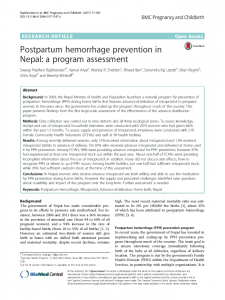
Background: In 2009, the Nepal Ministry of Health and Population launched a national program for prevention of postpartum hemorrhage (PPH) during home births that features advance distribution of misoprostol to pregnant women. In the years since, the government has scaled-up the program throughout much of the country. This paper presents findings from the first large-scale assessment of the effectiveness of the advance distribution program.
Methods: Data collection was carried out in nine districts and all three ecological zones. To assess knowledge, receipt and use of misoprostol, household interviews were conducted with 2070 women who had given birth within the past 12 months. To assess supply and provision of misoprostol, interviews were conducted with 270 Female Community Health Volunteers (FCHVs) and staff at 99 health facilities.
Results: Among recently delivered women, only 15% received information about misoprostol and 13% received misoprostol tablets in advance of delivery. Yet 87% who received advance misoprostol and delivered at home used it for PPH prevention. Among FCHVs, 96% were providing advance misoprostol for PPH prevention; however 81% had experienced at least one misoprostol stock out within the past year. About one-half of FCHVs were providing incomplete information about the use of misoprostol; in addition, many did not discuss side effects, how to recognize PPH or where to go if PPH occurs. Among health facilities, just one-half had sufficient misoprostol stock, while 95% had sufficient oxytocin stock, at the time of this assessment.
Conclusions: In Nepal, women who receive advance misoprostol are both willing and able to use the medication for PPH prevention during home births. However the supply and personnel challenges identified raise questions about scalability and impact of the program over the long-term. Further assessment is needed.